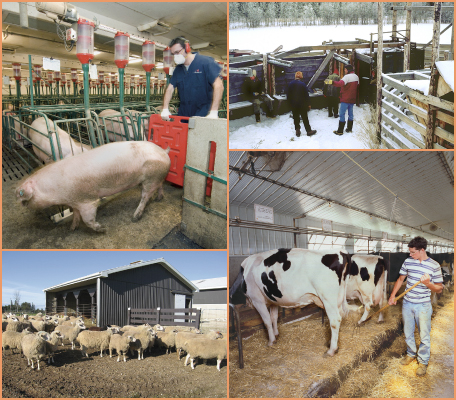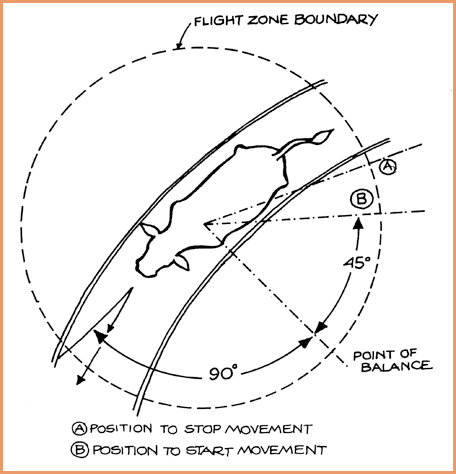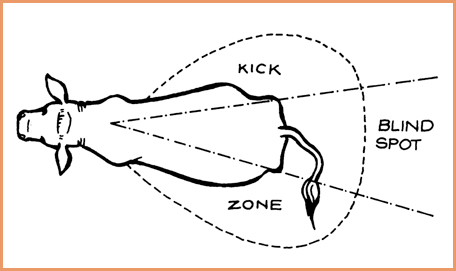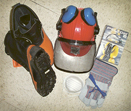Training Room 3: Keeping Safe and Healthy—Methods for Controlling Potential Hazards
Session 3: Managing the Risk—Animal-Handling Safety Procedures
Using effective health and safety practices and equipment when handling animals will prevent injury to workers and keep stress down for the livestock on the farm.

Top left: Courtesy of the MB Pork Council and The Canadian Agricultural Safety Association
Top right: Courtesy of Dr. John Church and The Canadian Agricultural Safety Association
Bottom right: Courtesy of Photobar Agricultural Stock Photography and The Canadian Agricultural Safety Association Bottom left: Courtesy of the University of Guelph and The Canadian Agricultural Safety Association
Learning Target
In this session you will describe and demonstrate your understanding of the use of common health and safety practices and equipment that should be used around animals. As you work through the session, keep the following question in mind:
- How do I use safety procedures and equipment on my agricultural worksite to keep myself safe from the hazards of animal handling?
Understanding Animal Psychology
Remember the concepts of flight zone, point of balance and blind spot that you learned about in Training Room 1? One of the best ways to avoid injury from animal handling is to understand animal behaviour.

Courtesy of the CFA and The Canadian Agricultural Safety Association

Courtesy of the CFA and The Canadian Agricultural Safety Association
Handling and Moving Animals
Use Your Understanding of Animal Behaviour to Move Animals in Large Areas
Alternating between penetrating the flight zones of animals and withdrawing from flight zones can help move livestock in a large, open area. By moving in a zig zag pattern, the handler penetrates the flight zone when walking in the opposite direction of the desired direction of movement and then retreating from the flight zone by walking in the same direction of the desired movement.
Tips to Improve Handling
- Have an even distribution of lighting where you are moving the animals. Shadows, bright spots and light glaring in the animals' eyes will distract the animals and cause them to stop.
- Provide level flooring with no bumps, dips or puddles.
- All handling facilities—loading ramps, single-file chutes and crowding pens—should have solid sides to prevent animals from
seeing distractions.
- Take advantage of cattle and sheep's natural tendency to turn by constructing curved chutes. This type of system places the handler on the edge of the animals' flight zones.
- Work smarter to get the lead animal moving. Pressuring the animals at the back of a large group does nothing to help move the animals forward.
Websites and Interactivities
To Do
-
Review the videos in Training Room 1: Session 5—Identifying Agricultural Hazards: Livestock Safety that apply to safe animal handling.
-
Choose and read two of the following articles for more information about safely handling animals on your worksite:
Read the article Understanding Flight Zone and Point of Balance to Improve Handling of Cattle, Sheep, and Pigs from the website of the famous animal handler, Dr. Temple Grandin. See the video links at the bottom of the article.
Read the flyer about the safe handling of swine from the Ontario Farm Animal Council. Handling Pigs: Work Smarter, Not Harder!
Handling Farm Animals Safely from the Farm Safety Association covers handling of many different kinds of animals on a farm, including sheep, horses, cattle and swine. It also includes information about ensuring facility safety and use of personal protective equipment.
Cattle Handling Safety in Working Facilities is an article from Oklahoma State University. It describes how various facilities on the farm should be set up to ensure handling safety for workers and farm animals.
Checking In
Your Task: Sharing Your Understanding of Safe Animal Handling Practices
To Do—Design an Animal Handling Facility for your Worksite
- Choose an animal that you work with regularly on your worksite or one that you would like to work with regularly.
- Design an animal handling facility that your animal might experience.
or analyze an animal handling facility that your animal currently experiences.
Your facility could be a corral, a catch pen that leads to an alley and then to a restraint device, a milking facility, a feeding facility, a loading and transportaton facility, a stable, etc. Use the resources and information from this course and search out resourses of your own, including other Internet sites and experts at your place of work.
Be sure to design and/or analyze your facility so that safe animal handling practices and equipment are included.
Include:
- how the facility is set up:
- size
- structure
- flooring
- safety equipment in the area
- how the animal moves in and out of the facility
- how workers move in and out of the facility
- animal behaviour strategies you would need to use to move the animal
- equipment you would use to move the animal and an explanation of how to use it
- Use the Animal Handling Facility Rubric to check your progress.
- Submit your design to your teacher.
-
If you want to demonstrate your understanding of animal-handling safety in your Health and Safety Action Plan, you can use the design you created above. Include instructions about the safety practices and equipment needed to protect workers on your worksite while they are handling animals in "your" facility. Add it to your collection of materials for your Health and Safety Action Plan.
Courtesy of Claude LeBlanc and The Canadian Agricultural Safety Association